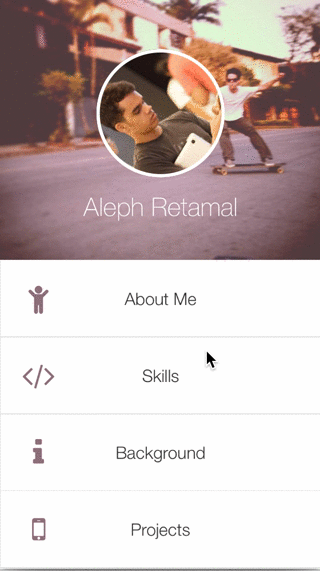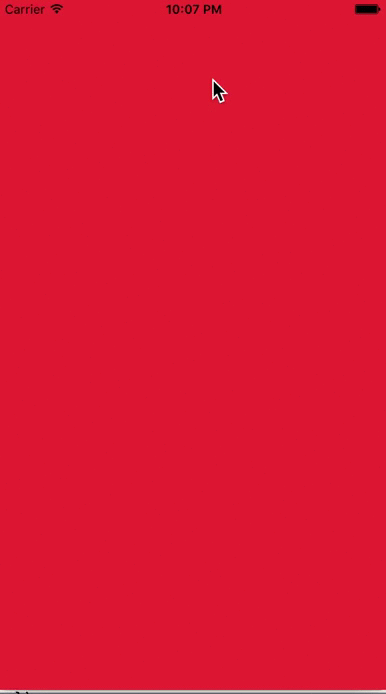how to create the depth page Transform animation (Top to bottom, bottom to Top) like this https://youtu.be/c2ccXwwmcnA . I searched in Google but I am not get any idea for how to Implement in iOS.
Sample Output Like this:

I followed the tutorial Animated Transitions in Swift and I got this effect:

TrasitionManager class//
// TransitionManager.swift
// Aleph Retamal
//
// Created by Aleph Retamal on 4/19/15.
// Copyright (c) 2015 Aleph Retamal. All rights reserved.
//
import UIKit
class TransitionManager: NSObject, UIViewControllerAnimatedTransitioning, UIViewControllerTransitioningDelegate {
private var presenting:Bool = true
var leftSide:Bool = true
// MARK: UIViewControllerAnimatedTransitioning protocol methods
// animate a change from one viewcontroller to another
func animateTransition(transitionContext: UIViewControllerContextTransitioning) {
// get reference to our fromView, toView and the container view that we should perform the transition in
let container = transitionContext.containerView()
let fromView = transitionContext.viewForKey(UITransitionContextFromViewKey)!
let toView = transitionContext.viewForKey(UITransitionContextToViewKey)!
let offScreenRight = CGAffineTransformConcat(CGAffineTransformMakeTranslation(container!.frame.width, 0), CGAffineTransformMakeScale(0.1, 0.1))
let offScreenLeft = CGAffineTransformMakeTranslation(-container!.frame.width, 0)
// start the toView to the right of the screen
if !leftSide {
if self.presenting {
toView.transform = offScreenRight
} else {
toView.transform = offScreenLeft
}
} else {
if self.presenting {
toView.transform = offScreenLeft
} else {
toView.transform = offScreenRight
}
}
// add the both views to our view controller
container!.addSubview(toView)
container!.addSubview(fromView)
// get the duration of the animation
// DON'T just type '0.5s' -- the reason why won't make sense until the next post
// but for now it's important to just follow this approach
let duration = self.transitionDuration(transitionContext)
// perform the animation!
// for this example, just slid both fromView and toView to the left at the same time
// meaning fromView is pushed off the screen and toView slides into view
// we also use the block animation usingSpringWithDamping for a little bounce
UIView.animateWithDuration(duration, animations: { () -> Void in
if !self.leftSide {
if self.presenting {
fromView.transform = offScreenLeft
} else {
container!.sendSubviewToBack(fromView)
fromView.transform = offScreenRight
}
} else {
if self.presenting {
fromView.transform = offScreenRight
container!.sendSubviewToBack(fromView)
} else {
fromView.transform = offScreenLeft
}
}
toView.transform = CGAffineTransformIdentity
}) { (finished) -> Void in
// tell our transitionContext object that we've finished animating
transitionContext.completeTransition(true)
}
}
// return how many seconds the transiton animation will take
func transitionDuration(transitionContext: UIViewControllerContextTransitioning?) -> NSTimeInterval {
return 1.0
}
// MARK: UIViewControllerTransitioningDelegate protocol methods
// return the animataor when presenting a viewcontroller
// remmeber that an animator (or animation controller) is any object that aheres to the UIViewControllerAnimatedTransitioning protocol
func animationControllerForPresentedController(presented: UIViewController, presentingController presenting: UIViewController, sourceController source: UIViewController) -> UIViewControllerAnimatedTransitioning? {
self.presenting = true
return self
}
// return the animator used when dismissing from a viewcontroller
func animationControllerForDismissedController(dismissed: UIViewController) -> UIViewControllerAnimatedTransitioning? {
self.presenting = false
return self
}
}
This is where you set how the views should transform
let offScreenRight = CGAffineTransformConcat(CGAffineTransformMakeTranslation(container!.frame.width, 0), CGAffineTransformMakeScale(0.1, 0.1))
let offScreenLeft = CGAffineTransformMakeTranslation(-container!.frame.width, 0)
In this case, one view will Translate + Scale while the other one will only Translate
TransitionManager inside your ViewController
let transitionManager = TransitionManager()
override func prepareForSegue(segue: UIStoryboardSegue, sender: AnyObject?) {
transitionManager.leftSide = false
let toViewController = segue.destinationViewController
toViewController.transitioningDelegate = self.transitionManager
}
If you want the view to come from the right, leftSide = false
transitionManager.leftSide = false
That's it!
To achieve this effect:

Here's a git with the project: https://github.com/alaphao/indepth
Use constraints for alignment an sizing:
Create 2 views with same width / height of their parent view
Align both with CenterX
Set both distance from bottom = 0 and create an outlet for the constraints
Create a PanGestureRecognizer
Animate the front view bottom constraint accordingly to the pan translationInView.y
Here is the solution make new swift file and copy this code
import UIKit
class UltravisualLayout: UICollectionViewLayout {
private var contentWidth:CGFloat!
private var contentHeight:CGFloat!
private var yOffset:CGFloat = 0
var maxAlpha:CGFloat = 1
var minAlpha:CGFloat = 0
//DEFAULT VALUES
//var widthOffset:CGFloat = 35
// var heightOffset:CGFloat = 35
var widthOffset:CGFloat = 100
var heightOffset:CGFloat = 100
private var cache = [UICollectionViewLayoutAttributes]()
private var itemWidth:CGFloat{
return (collectionView?.bounds.width)!
}
private var itemHeight:CGFloat{
return (collectionView?.bounds.height)!
}
private var collectionViewHeight:CGFloat{
return (collectionView?.bounds.height)!
}
private var numberOfItems:Int{
return (collectionView?.numberOfItemsInSection(0))!
}
private var dragOffset:CGFloat{
return (collectionView?.bounds.height)!
}
private var currentItemIndex:Int{
return max(0, Int(collectionView!.contentOffset.y / collectionViewHeight))
}
var nextItemBecomeCurrentPercentage:CGFloat{
return (collectionView!.contentOffset.y / (collectionViewHeight)) - CGFloat(currentItemIndex)
}
override func prepareLayout() {
cache.removeAll(keepCapacity: false)
yOffset = 0
for item in 0 ..< numberOfItems{
let indexPath = NSIndexPath(forItem: item, inSection: 0)
let attribute = UICollectionViewLayoutAttributes(forCellWithIndexPath: indexPath)
attribute.zIndex = -indexPath.row
if (indexPath.item == currentItemIndex+1) && (indexPath.item < numberOfItems){
attribute.alpha = minAlpha + max((maxAlpha-minAlpha) * nextItemBecomeCurrentPercentage, 0)
let width = itemWidth - widthOffset + (widthOffset * nextItemBecomeCurrentPercentage)
let height = itemHeight - heightOffset + (heightOffset * nextItemBecomeCurrentPercentage)
let deltaWidth = width/itemWidth
let deltaHeight = height/itemHeight
attribute.frame = CGRectMake(0, yOffset, itemWidth, itemHeight)
attribute.transform = CGAffineTransformMakeScale(deltaWidth, deltaHeight)
attribute.center.y = (collectionView?.center.y)! + (collectionView?.contentOffset.y)!
attribute.center.x = (collectionView?.center.x)! + (collectionView?.contentOffset.x)!
yOffset += collectionViewHeight
}else{
attribute.frame = CGRectMake(0, yOffset, itemWidth, itemHeight)
attribute.center.y = (collectionView?.center.y)! + yOffset
attribute.center.x = (collectionView?.center.x)!
yOffset += collectionViewHeight
}
cache.append(attribute)
}
}
//Return the size of ContentView
override func collectionViewContentSize() -> CGSize {
contentWidth = (collectionView?.bounds.width)!
contentHeight = CGFloat(numberOfItems) * (collectionView?.bounds.height)!
return CGSizeMake(contentWidth, contentHeight)
}
//Return Attributes whose frame lies in the Visible Rect
override func layoutAttributesForElementsInRect(rect: CGRect) -> [UICollectionViewLayoutAttributes]? {
var layoutAttributes = [UICollectionViewLayoutAttributes]()
for attribute in cache{
if CGRectIntersectsRect(attribute.frame, rect){
layoutAttributes.append(attribute)
}
}
return layoutAttributes
}
override func shouldInvalidateLayoutForBoundsChange(newBounds: CGRect) -> Bool {
return true
}
override func targetContentOffsetForProposedContentOffset(proposedContentOffset: CGPoint, withScrollingVelocity velocity: CGPoint) -> CGPoint {
let itemIndex = round(proposedContentOffset.y / (dragOffset))
let yOffset = itemIndex * (collectionView?.bounds.height)!
return CGPoint(x: 0, y: yOffset)
}
override func layoutAttributesForItemAtIndexPath(indexPath: NSIndexPath) -> UICollectionViewLayoutAttributes? {
// Logic that calculates the UICollectionViewLayoutAttributes of the item
// and returns the UICollectionViewLayoutAttributes
return UICollectionViewLayoutAttributes(forCellWithIndexPath: indexPath)
}
}
In Main.storyboard file use UICollectionView or UICollectionViewController
component select UICollectionView go to attributes inspector and change Layout from Flow to custom and set class attribute to UltravisualLayout
here is the project link and this link to the tutorial
Hope This might help GOOD LUCK..
If you love us? You can donate to us via Paypal or buy me a coffee so we can maintain and grow! Thank you!
Donate Us With